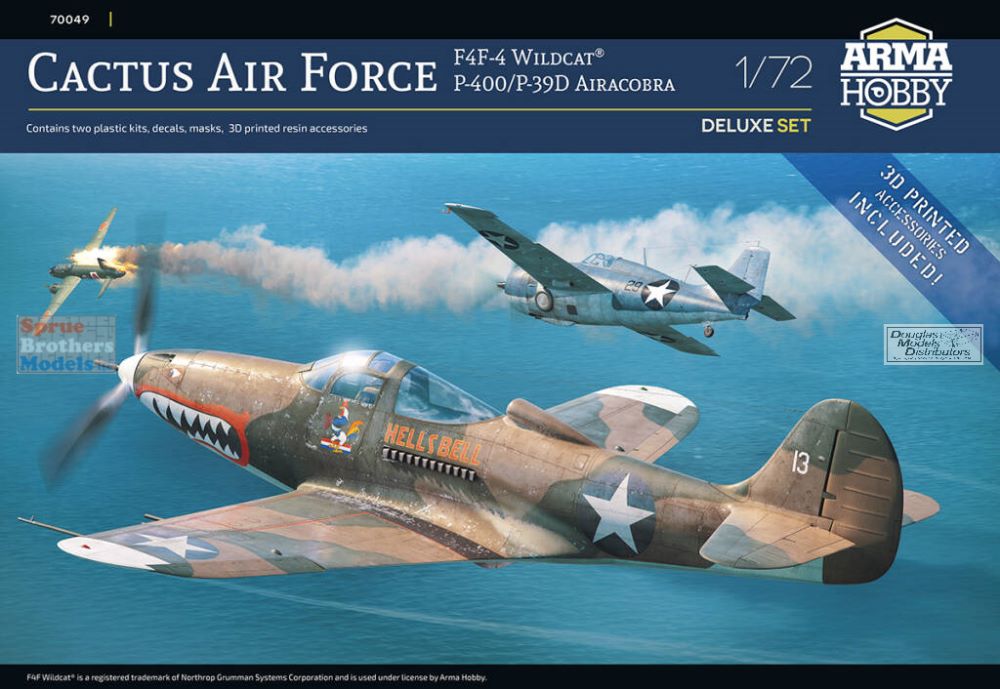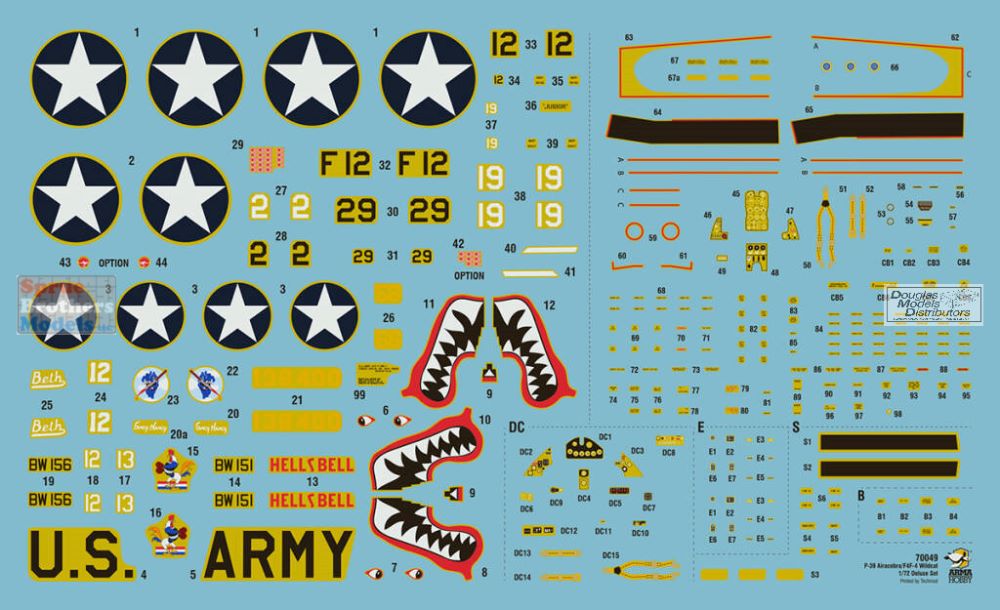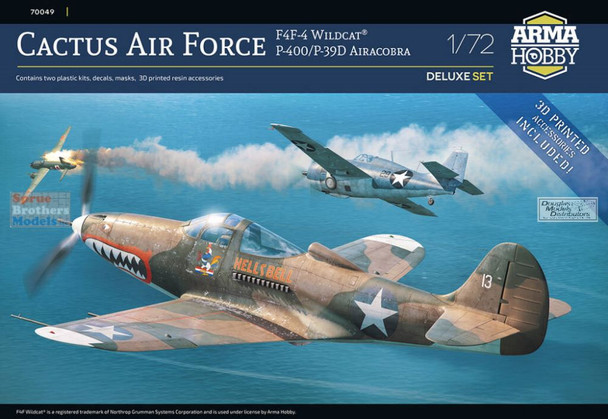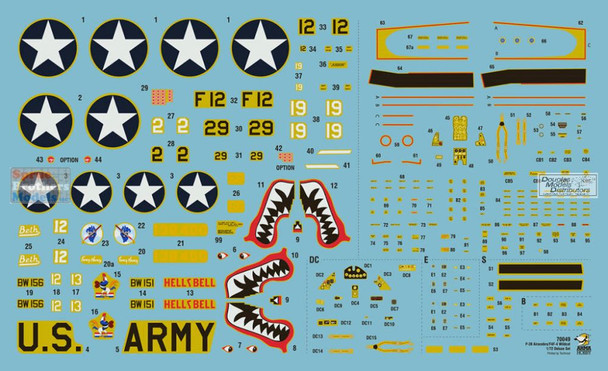Arma Hobby
ARM70049 1:72 Arma Hobby Cactus Air Force Deluxe Set (F4F-4 Wildcat & P-400/P-39D Airacobra)
- SKU:
- ARM70049
- UPC:
- 5902734373458
- MPN:
- 70049
- Scale:
- 1/72
- Subject:
- F4F Wildcat
- Subject:
- P-39 Airacobra
Description


Double kit with accessories. The set includes F4F-4 Wildcat and P-400/P-39D Airacobra kits with 3D-printed resin accessories.
Set includes:
- One set of F4F-4 Wildcat plastic sprues
- one set P-400/P-39D Airacobra plastic sprues
- decal with eight marking options (4 Wildcats and 4 Airacobras)
- painting masks for both models
- 3D printed accessories for F4F-4 Wildcat
- 3D printed accessories for P-39D/P-400 Airacobra.
F4F-4 Wildcat Accessories
- Seat with seatbelts
- undercarriage retracting system chains
- exhaust tubes
- external 0,5-inch gun barrels
- bomb racks
- two 100 lbs bombs
- magneto spark ignition wiring ring
- throttle and undercarriage retracting levers
P-39D/P-400 Airacobra Accessories
- Seat with seatbelts
- two variants of the exhausts
- 37 mm cannon barrell
- 20 mm cannon barrell
- fuselage machine gun butts with the cocking levers next to the instrument panel
- two small levers to the cockpit
- wing machine guns barrels
Camouflage and Markings
- P-400 Airacobra „white 13” „Hells Bell”, BW151, 67FS/347FG, pilot Lt. Robert M. Ferguson, Guadalcanal, August-November 1942.
- P-39D-2 Airacobra „white 12” „Beth”, Cpt. Paul Bechtel, 12FS commander, Guadalcanal, December 1942.
- P-400 Airacobra „white 12”, BW156, pilot Lt. Richard Johnson 67FS/347FG „Fancy Nancy”, Guadalcanal August-September 1942.
- P-39D-1 Airacobra „yellow 56” 41-38400, 68FS/347FG, Guadalcanal, December 1942. Piloting this aeroplane Lt. Vernon Head of 67FS performed a bombing attack over New Georgia.
- F4F-4 Wildcat „black 29”, pilot Lt. Samuel Folsom, VMF-121, Guadalcanal. Piloting this aeroplane Sam Folsom shot down two G4M1 Betty bombers on 12th November 1942.
- F4F-4 Wildcat „white 2”, pilot Mjr. Marion E. Carl, VMF-223, Guadalcanal, February 1943.
- F4F-4 Wildcat „black F-12” BuNo. 5192, pilot Lt. James „Pug” Southerland II, VF-5/USS Saratoga. On 7th August 1942, this aeroplane downed the first Japanese bomber over Guadalcanal before Saburo Sakai himself shot it down in epic lonely combat against a flight of “Zeros”.
- F4F-4 Wildcat „white 19” BuNo. 03417, pilot Lt. Stanley W. „Swede” Vejtasa, VF-10/USS Enterprise. During the Santa Cruz Battle on 26th October 1942 Vejtasa shot down two dive bombers and five torpedo aeroplanes in one sortie.
Cactus Air Force
"Cactus" was the code name for the US air base on Guadalcanal, an island that faced heavy fights in the second half of 1942. The combined forces of the US Marine Corps, US Navy and USAAF stopped the onslaught of a Japanese invasion for the first time in the war. This would not have been done without a combined air force called the Cactus Air Force. This informal unit operated from the summer of 1942 to the spring of 1943, when its structure was reorganised as part of the 13th Air Force.
The Marines landed on the island on August 7, 1942. The first US aircraft over Guadalcanal came from the aircraft carriers USS Saratoga and USS Enterprise. They repulsed two waves of G4M Betty bombers escorted by Zeros, inflicting heavy losses on them. The Americans quickly finished the runway and named the base Henderson Field (a USMC officer killed in the Battle of Midway). On August 20, the first Marine aeroplanes were landed there, SBD bombers from VMSB-232 and F4F-4 Wildcat fighters from VMF-223, delivered by the aircraft carrier USS Long Island. P-400 Airacobras from the 67th USAAF Squadron joined them two days later..
Japanese tactics were based on massive air raids, land attacks and shelling from the sea. Cactus Air Force pilots repulsed air raids, supported infantry operations by bombing Japanese positions, and fought enemy supply transports as far as possible. Subsequent USMC and USAAF units arriving on the island wore out quickly, their structure was blurred, and the healthy pilots at the time flew on available planes from all squadrons. The culmination came in a series of air-sea battles on November 11-14, 1942, when Japanese reinforcements being transported to Guadalcanal were repelled. From December 1942, the Japanese began withdrawing from the island. During this period, Cactus Air Force aircraft began actively attacking neighbouring islands and shipping on the approaches to Guadalcanal. In April 1943, the enemy made the last attempt at a massive air offensive on the island, which ended in failure.
The primary Cactus Air Force fighters were the F4F-4 Wildcats and the P-400/P-39D Airacobras. The former was mainly used as an interceptor (it had better performance at higher altitudes), the latter as a ground-attack aircraft (it had poor performance at high altitudes, but the 20mm or 37mm cannon was effective at attacking ground targets). These aircraft were supplemented with P-38 and P-40 machines (November-December 1942) and F4U-1 Corsair (spring 1943). However, the main weight of the fights in the hottest period rested on Wildcats and Airacobras.




